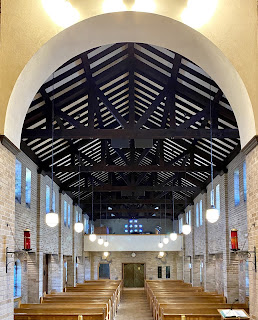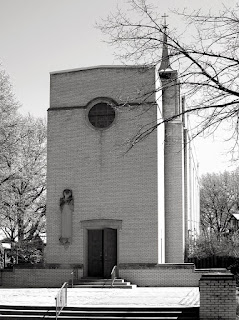A 1951 Harris Armstrong-designed home is now on the market in Kirkwood. It's located in a special neighborhood, a cul-de-sac with 10 Armstrong-designed homes of the same overall design with exposed heavy timber beams supporting low-sloped roofs. The neighborhood is compact and the homes are coordinated in scale, design, and detail. The series of floor plans vary according to their location (north or south side of the street) and other requirements of the original owners. The street was recently given a Neighborhood of Distinction award by the City of Kirkwood. The ensemble is well-preserved with a consistent mid-century charm.
 |
| 501 Woodleaf Court, Kirkwood (Harris Armstrong, 1951), Photo: Raimist. |
The property for sale is 501 Woodleaf Court located on the corner where it joins Woodlawn Avenue. The house is typical for developments of that era with a compact floor plan (1,354 sq. ft.), three bedrooms, and 1-1/2 baths. The neighborhood was developed by Marshall Berry with whom Armstrong collaborated on many projects in the 1950s. He designed Berry's own home on Danfield Road in Ladue in 1949 and his real estate office in Brentwood the year before that. The Berry home had a floor plan following the same principles as the Solar House and these homes on Woodleaf Court. Subsequently, they collaborated on many commercial projects along Manchester Road and several residential subdivisions. The Woodleaf Court development is unique in that every home was of Armstrong's design.
 |
| Woodleaf Court Subdivision, Site Plan (Armstrong, 1951), Base image by Susan Halla. |
The overall design of these homes fit into the concept for a Missouri Solar Home that Armstrong published in 1947. The overhanging eaves and glazing are coordinated to keep out direct sun in the summer months and to allow direct sunlight to warm and brighten the interior during winter. Each house is a split level with a garage tucked under the upper level, the main level with living, dining, and kitchen, and the bedrooms located on the topmost level. The public spaces of each house feature tall ceilings and glazing facing toward both the street and backyard. The continuous heavy timber beams span from front to back and are exposed within and on each elevation.
 |
| 513 Woodleaf Court, Kirkwood (Armstrong, 1951), Photo: Raimist. |
The floor plans vary according to their position on the north or south side of the street. The small, compact functional rooms and closets of the house are grouped on the north side of each plan. For the houses on the north side of the street, that means these rooms are grouped facing the backyard. For the houses on the south side of the street, these smaller rooms are grouped on the north side, appearing on the street facade. For the houses along the south side, pairs of small windows on the main facade indicate the bathroom and kitchen. (Note: the floor plan shown below is for Armstrong's 1949 house for the developer Marshall Berry.)
 |
| Berry Residence, Ladue (Armstrong, 1949) |
Each house is unique in its materials, colors, and finishes. The volumetric shape of each structure is generally consistent but the openings and cladding of each vary. The functions of each interior spaces are telegraphed by the fenestration. Large, fully glazed walls indicate the public gathering spaces each one with a masonry fireplace. The bedrooms have mid-sized windows and the bathrooms and kitchens have the smallest openings. The plans are predictably skewed by the gender roles common in the period. The kitchens are quite small and divided visually and spatially from the main living spaces. Fortunately, the houses allow for expanding the kitchen to meet late 20th Century needs and desires. Many of the homes have been renovated in just this way.
 |
| 500 Woodleaf Court, Kirkwood (Armstrong, 1951), Photo: Raimist. |
The families in the neighborhood have been good caretakers of their homes and properties. They typically are long-term residents with a strong commitment to Kirkwood and their unique piece of 1950s mid-century modern design. As I've been photographing and documenting these homes this year, I've learned that each has a story to tell of its succession of owners and the ways they've adjusted the spaces to fit their own needs.
 |
| 519 Woodleaf Court, Kirkwood (Armstrong, 1951), Photo: Raimist. |
From a planning perspective, Armstrong chose to design each home so its main entry door was directly visible to those driving in from Woodlawn Avenue. Each entry is surrounded by glazing and marked by a tilted column rising from a modest front porch. The entries are set back from the front wall of the house to provide additional protection from the elements. The deeper shadows create an inviting spot next to the center of each facade. The garages are recessed in elevation and located on the east end of each home so it is not the first thing one encounters. Instead, landscaped, gentle slopes frame the formal entry and the two-car garages are deemphasized.
 |
| 533 Woodleaf Court, Kirkwood (Armstrong, 1951), Photo: Raimist. |
The Open House for 501 Woodleaf Court is being held on Sunday, June 20 from 1 to 3 pm. I anticipate this will be the only open house showing. Houses in Kirkwood sell very quickly. You can see the complete listing by Coldwell-Banker Premier Group here.

















